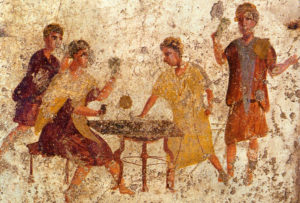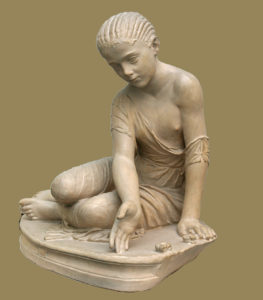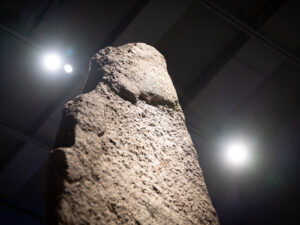
Playing with bones
Games are as old as mankind itself. In ancient times, people used specially shaped bones as dice.
The knucklebone is a bone from the ankle joint of the rear legs of mammals. It is used in the rolling motion of the foot when walking and jumping. Even in prehistoric times, knucklebones served as pendants. They were also used for some games as well as for fortune telling. Their shape must have always fascinated people.
The knucklebones of sheep, goats, cattle, roe deer and deer in general have four surfaces at right angles to each other. If a knucklebone of this kind is thrown or rolled, it lands on one of the four surfaces randomly: a four-sided dice, which was then also promptly copied in gold, silver, bronze, lead, glass and clay. Such artificial imitations were also used as pendants and dice.
A striking number of sheep knucklebones have been found in the graves of children in the Near and Middle East. The number of knucklebones in a child’s possession may be evidence of that child’s skill at playing with such dice as the winner also won the opponent’s knucklebones. It may also be related to the size of the herd of sheep belonging to the family concerned: Every time a sheep was slaughtered, there would be two more knucklebones.
We know from pictorial depictions and written accounts how they played with knucklebones in ancient times. Rolling dice was very common in the Roman period. Values from 1 to 4 were ascribed to the four sides of the knucklebone. Back then – just like today when rolling dice – the value visible on top was the one that counted. A throw with four knucklebones allowed 35 different possibilities. Two of them were considered special: The “Venus Throw”, in which each value appeared once, always won. The combination 1-3-4-6 was considered good luck and was also frequently imprinted into the lead of ships’ anchors. On the other hand, the “Dog” with the number 1 appearing four times was a definite loser. Sometimes, the sides for the values 1 or 3 were ground down; this improved the chances of higher numbers. People obviously manipulated the statistical frequency and therefore their own luck – and this was well before the computer age.

Statue of a girl playing with knucklebone dice, 130–150 BC. Berlin Museum of Classical Antiquities. Photo: Wikimedia

Roman knucklebones in bronze, Greece. Photo: Swiss National Museum

Dice player. Roman fresco from the back room of the Osteria della Via di Mercurio in Pompeii. Photo: Wikimedia



